Construction of Cultural Heritage Tourism Corridor for the Dissemination of Historical Culture: A Case Study of Typical Mountainous Multi-Ethnic Area in China
Abstract
1. Introduction
2. Materials and Methods
2.1. Study Area
2.2. Methods
- (1)
- Basic geographic data, such as administrative boundaries, water systems, and roads, were downloaded from the Resource and Environment Science and Data Centre (https://www.resdc.cn/, accessed on 1 July 2021).
- (2)
- Statistical data on Xiangxi Prefecture cultural sources (up to 2021), including Chinese Traditional Villages, Cultural Relic Protection Units (national and provincial levels), Intangible Cultural Heritage (ICH) (national and provincial levels), famous historical and cultural cities, towns, and villages at the national and provincial levels, were collected by the Bureau of Culture and Tourism in Xiangxi Prefecture (http://whlygdj.xxz.gov.cn/, accessed on 30 September 2021).
- (3)
- Indicators for evaluating cultural dissemination resistance included the digital elevation model (DEM), slope, land use and land cover (LULC), ethnic minority population density (EMPD), and spatial distribution of the gross domestic product (GDP). The original and processed data information for each factor are shown in Table 1.
2.2.1. Identification of Cultural Space
Determination of Cultural Sources
Evaluation of Cultural Dissemination Resistance
Creation of an Integrated Resistance Surface
Extraction of Cultural Space Boundary
2.2.2. Identification of Potential Cultural Tourism Corridors
2.2.3. Creation of a Cultural Heritage Tourism Corridor Network
- (1)
- When there were highways between the nodes, priority was given to the use of existing highways. If several highways were available, the highway with a higher administrative grade was prioritized.
- (2)
- When there were no highways between the nodes, potential corridors were used. If there were several potential corridors, one was selected in order of priority as Level 1, Level 2, and Level 3. If a section of a potential corridor overlaps with an existing road, that section could use the existing road.
- (3)
- There should be only three corridors linking a node.
- (4)
- Historical and culturally significant navigable waterways were used to supplement the corridors. Depending on the actual scenario, a marina may be built at the junction of a waterway and a potential corridor.
3. Results
3.1. Cultural Dissemination Resistance Surface
3.2. Cultural Space
3.3. Potential Cultural Heritage Tourism Corridors
3.4. Cultural Heritage Tourism Corridor Network
4. Discussion
5. Conclusions
Author Contributions
Funding
Institutional Review Board Statement
Informed Consent Statement
Data Availability Statement
Conflicts of Interest
References
- Michaud, J.; Ovesen, J. Turbulent Times and Enduring Peoples: Mountain Minorities in the South-East Asian Massif; Routledge: London, UK, 2013; ISBN 1136827811. [Google Scholar]
- Salzer, A.K. Knowledge for Sustainability-Cultural Capital of Ethnic Minorities in High Mountain Areas of the South Caucasus; Agricultural Knowledge and Knowledge Systems in Post-Soviet Societies; Peter Lang: Bern, Switzerland, 2016; pp. 127–156. [Google Scholar] [CrossRef]
- Goldstein, P.S. Multiethnicity, Pluralism, and Migration in the South Central Andes: An Alternate Path to State Expansion. Proc. Natl. Acad. Sci. USA 2015, 112, 9202–9209. [Google Scholar] [CrossRef] [PubMed]
- Yang, L.; Wall, G.; Smith, S.L.J. Ethnic Tourism Development: Chinese Government Perspectives. Ann. Tour. Res. 2008, 35, 751–771. [Google Scholar] [CrossRef]
- Yang, L.; Wall, G. Authenticity in Ethnic Tourism: Domestic Tourists’ Perspectives. Curr. Issues Tour. 2009, 12, 235–254. [Google Scholar] [CrossRef]
- Anderson, W. Cultural Tourism and Poverty Alleviation in Rural Kilimanjaro, Tanzania. J. Tour. Cult. Chang. 2015, 13, 208–224. [Google Scholar] [CrossRef]
- Tu, J.; Zhang, D. Does Tourism Promote Economic Growth in Chinese Ethnic Minority Areas? A Nonlinear Perspective. J. Destin. Mark. Manag. 2020, 18, 100473. [Google Scholar] [CrossRef]
- Mowforth, M.; Munt, I. Tourism and Sustainability: Development, Globalisation and New Tourism in the Third World; Routledge: London, UK, 2015; ISBN 1315795345. [Google Scholar]
- Tian, B.; Stoffelen, A.; Vanclay, F. Ethnic Tourism in China: Tourism-Related (Dis)Empowerment of Miao Villages in Hunan Province. Tour. Geogr. 2021, 1–20. [Google Scholar] [CrossRef]
- Sati, V.P. Carrying Capacity Analysis and Destination Development: A Case Study of Gangotri Tourists/Pilgrims’ Circuit in the Himalaya. Asia Pac. J. Tour. Res. 2018, 23, 312–322. [Google Scholar] [CrossRef]
- Xu, H.; Zhao, G.; Fagerholm, N.; Primdahl, J.; Plieninger, T. Participatory Mapping of Cultural Ecosystem Services for Landscape Corridor Planning: A Case Study of the Silk Roads Corridor in Zhangye, China. J. Environ. Manag. 2020, 264, 110458. [Google Scholar] [CrossRef]
- Liu, G.; Yang, Z.; Chen, B.; Zhang, L.; Zhang, Y.; Su, M. An Ecological Network Perspective in Improving Reserve Design and Connectivity: A Case Study of Wuyishan Nature Reserve in China. Ecol. Model. 2015, 306, 185–194. [Google Scholar] [CrossRef]
- Zhou, D.; Song, W. Identifying Ecological Corridors and Networks in Mountainous Areas. Int. J. Environ. Res. Public Health 2021, 18, 4797. [Google Scholar] [CrossRef]
- Forman, R.T.T. Some General Principles of Landscape and Regional Ecology. Landsc Ecol 1995, 10, 133–142. [Google Scholar] [CrossRef]
- Hess, G.R.; Fischer, R.A. Communicating Clearly about Conservation Corridors. Landsc. Urban Plan 2001, 55, 195–208. [Google Scholar] [CrossRef]
- Xu, H.; Plieninger, T.; Primdahl, J. A Systematic Comparison of Cultural and Ecological Landscape Corridors in Europe. Land 2019, 8, 41. [Google Scholar] [CrossRef]
- Zhang, S.; Liu, J.; Pei, T.; Chan, C.-S.; Wang, M.; Meng, B. Tourism Value Assessment of Linear Cultural Heritage: The Case of the Beijing–Hangzhou Grand Canal in China. Curr. Issues Tour. 2021, 1–23. [Google Scholar] [CrossRef]
- Boley, B.B.; Gaither, C.J. Exploring Empowerment within the Gullah Geechee Cultural Heritage Corridor: Implications for Heritage Tourism Development in the Lowcountry. J. Herit. Tour. 2016, 11, 155–176. [Google Scholar] [CrossRef]
- Conzen, M.P.; Wulfestieg, B.M. Metropolitan Chicago’s Regional Cultural Park: Assessing the Development of the Illinois \& Michigan Canal National Heritage Corridor. J. Geogr. 2001, 100, 111–117. [Google Scholar] [CrossRef]
- Murray, M.; Graham, B. Exploring the Dialectics of Route-Based Tourism: The Camino de Santiago. Tour. Manag. 1997, 18, 513–524. [Google Scholar] [CrossRef]
- Orbaşli, D.A.; Woodward, S. A Railway ‘Route’ as a Linear Heritage Attraction: The Hijaz Railway in the Kingdom of Saudi Arabia. J. Herit. Tour. 2008, 3, 159–175. [Google Scholar] [CrossRef]
- Li, H.; Jing, J.; Fan, H.; Li, Y.; Liu, Y.; Ren, J. Identifying Cultural Heritage Corridors for Preservation through Multidimensional Network Connectivity Analysis—A Case Study of the Ancient Tea-Horse Road in Simao, China. Landsc. Res. 2020, 46, 96–115. [Google Scholar] [CrossRef]
- Oikonomopoulou, E.; Delegou, E.T.; Sayas, J.; Moropoulou, A. An Innovative Approach to the Protection of Cultural Heritage: The Case of Cultural Routes in Chios Island, Greece. J. Archaeol. Sci. Rep. 2017, 14, 742–757. [Google Scholar] [CrossRef]
- Balakrishnan, J.; Dwivedi, Y.K.; Malik, F.T.; Baabdullah, A.M. Role of Smart Tourism Technology in Heritage Tourism Development. J. Sustain. Tour. 2021, 1–20. [Google Scholar] [CrossRef]
- Palmi, P.; Esposito, M.; Prete, M.I. Change in Perspectives in Cultural Tourism: A Sustainable Managerial Model for Cultural Thematic Routes Creating Territorial Value. In Contributions to Management Science; Springer: Berlin/Heidelberg, Germany, 2021; pp. 199–223. [Google Scholar] [CrossRef]
- Hoppert, M.; Bahn, B.; Bergmeier, E.; Deutsch, M.; Epperlein, K.; Hallmann, C.; Müller, A.; Platz, T.V.; Reeh, T.; Stück, H.; et al. The Saale-Unstrut Cultural Landscape Corridor. Environ. Earth Sci. 2018, 77, 58. [Google Scholar] [CrossRef]
- Shishmanova, M.V. Cultural Tourism in Cultural Corridors, Itineraries, Areas and Cores Networked. Procedia Soc. Behav. Sci. 2015, 188, 246–254. [Google Scholar] [CrossRef]
- Wu, S.; Li, B.V. Sustainable Linear Infrastructure Route Planning Model to Balance Conservation and Socioeconomic Development. Biol. Conserv. 2022, 266, 109449. [Google Scholar] [CrossRef]
- Dong, J.; Guo, F.; Lin, M.; Zhang, H.; Zhu, P. Optimization of Green Infrastructure Networks Based on Potential Green Roof Integration in a High-Density Urban Area—A Case Study of Beijing, China. Sci. Total Environ. 2022, 834, 155307. [Google Scholar] [CrossRef]
- Stucky, J.L.D. On Applying Viewshed Analysis for Determining Least-Cost Paths on Digital Elevation Models. Int. J. Geogr. Inf. Sci. 1998, 12, 891–905. [Google Scholar] [CrossRef]
- Akimov, A.V.; Gemueva, K.A.; Semenova, N.K. The Seventh Population Census in the PRC: Results and Prospects of the Country’s Demographic Development. Her. Russ. Acad. Sci. 2021, 91, 724–735. [Google Scholar] [CrossRef]
- Su, J.; Sun, J. Spatial Changes of Ethnic Communities during Tourism Development: A Case Study of Basha Miao Minority Community. J. Tour. Cult. Chang. 2020, 18, 333–350. [Google Scholar] [CrossRef]
- Liu, C.; Wu, L.; Xu, M.; Zeng, F.; Jiao, L. Building National Eco-Cultural Protection Areas and the Xiangxi Practice in Hunan Province. J. Geogr. Sci. 2020, 30, 2076–2092. [Google Scholar] [CrossRef]
- Zhang, X.; Xiang, H.; Liu, R. Spatial Pattern and Influencing Factors of Intangible Cultural Heritage of Music in Xiangxi, Central China. Herit. Sci. 2022, 10, 39. [Google Scholar] [CrossRef]
- Chen, X.; Xie, W.; Li, H. The Spatial Evolution Process, Characteristics and Driving Factors of Traditional Villages from the Perspective of the Cultural Ecosystem: A Case Study of Chengkan Village. Habitat. Int. 2020, 104, 102250. [Google Scholar] [CrossRef]
- Bian, J.; Chen, W.; Zeng, J. Spatial Distribution Characteristics and Influencing Factors of Traditional Villages in China. Int. J. Environ. Res. Public Health 2022, 19, 4627. [Google Scholar] [CrossRef] [PubMed]
- Li, W.; Jiao, J.; Qi, J.; Ma, Y. The Spatial and Temporal Differentiation Characteristics of Cultural Heritage in the Yellow River Basin. PLoS ONE 2022, 17, 1–20. [Google Scholar] [CrossRef]
- Cao, Y.; Yang, R.; Carver, S. Linking Wilderness Mapping and Connectivity Modelling: A Methodological Framework for Wildland Network Planning. Biol. Conserv. 2020, 251, 108679. [Google Scholar] [CrossRef]
- Huang, L.; Wang, J.; Cheng, H. Spatiotemporal Changes in Ecological Network Resilience in the Shandong Peninsula Urban Agglomeration. J. Clean. Prod. 2022, 339, 130681. [Google Scholar] [CrossRef]
- Han, B.; Liu, H.; Wang, R. Urban Ecological Security Assessment for Cities in the Beijing–Tianjin–Hebei Metropolitan Region Based on Fuzzy and Entropy Methods. Ecol. Model. 2015, 318, 217–225. [Google Scholar] [CrossRef]
- Ludovisi, A. Effectiveness of Entropy-Based Functions in the Analysis of Ecosystem State and Development. Ecol. Indic. 2014, 36, 617–623. [Google Scholar] [CrossRef]
- Dai, P.; Zhang, S.; Gong, Y.; Yang, Y.; Hou, H. Assessing the Inspirational Value of Cultural Ecosystem Services Based on the Chinese Poetry. Acta Ecol. Sin. 2022, 42, 467–475. [Google Scholar] [CrossRef]
- Tang, Z. An Integrated Approach to Evaluating the Coupling Coordination between Tourism and the Environment. Tour. Manag. 2015, 46, 11–19. [Google Scholar] [CrossRef]
- McRae, B.H.; Shah, V.B. Circuitscape User’s Guide; The University of California: Santa Barbara, CA, USA, 2009. [Google Scholar]
- Adriaensen, F.; Chardon, J.P.; de Blust, G.; Swinnen, E.; Villalba, S.; Gulinck, H.; Matthysen, E. The Application of ‘Least-Cost’ Modelling as a Functional Landscape Model. Landsc. Urban Plan 2003, 64, 233–247. [Google Scholar] [CrossRef]
- Dai, L.; Liu, Y.; Luo, X. Integrating the MCR and DOI Models to Construct an Ecological Security Network for the Urban Agglomeration around Poyang Lake, China. Sci. Total Environ. 2021, 754, 141868. [Google Scholar] [CrossRef] [PubMed]
- Huang, H.; Zhang, M.; Yu, K.; Gao, Y.; Liu, J. Construction of Complex Network of Green Infrastructure in Smart City under Spatial Differentiation of Landscape. Comput. Commun. 2020, 154, 380–389. [Google Scholar] [CrossRef]
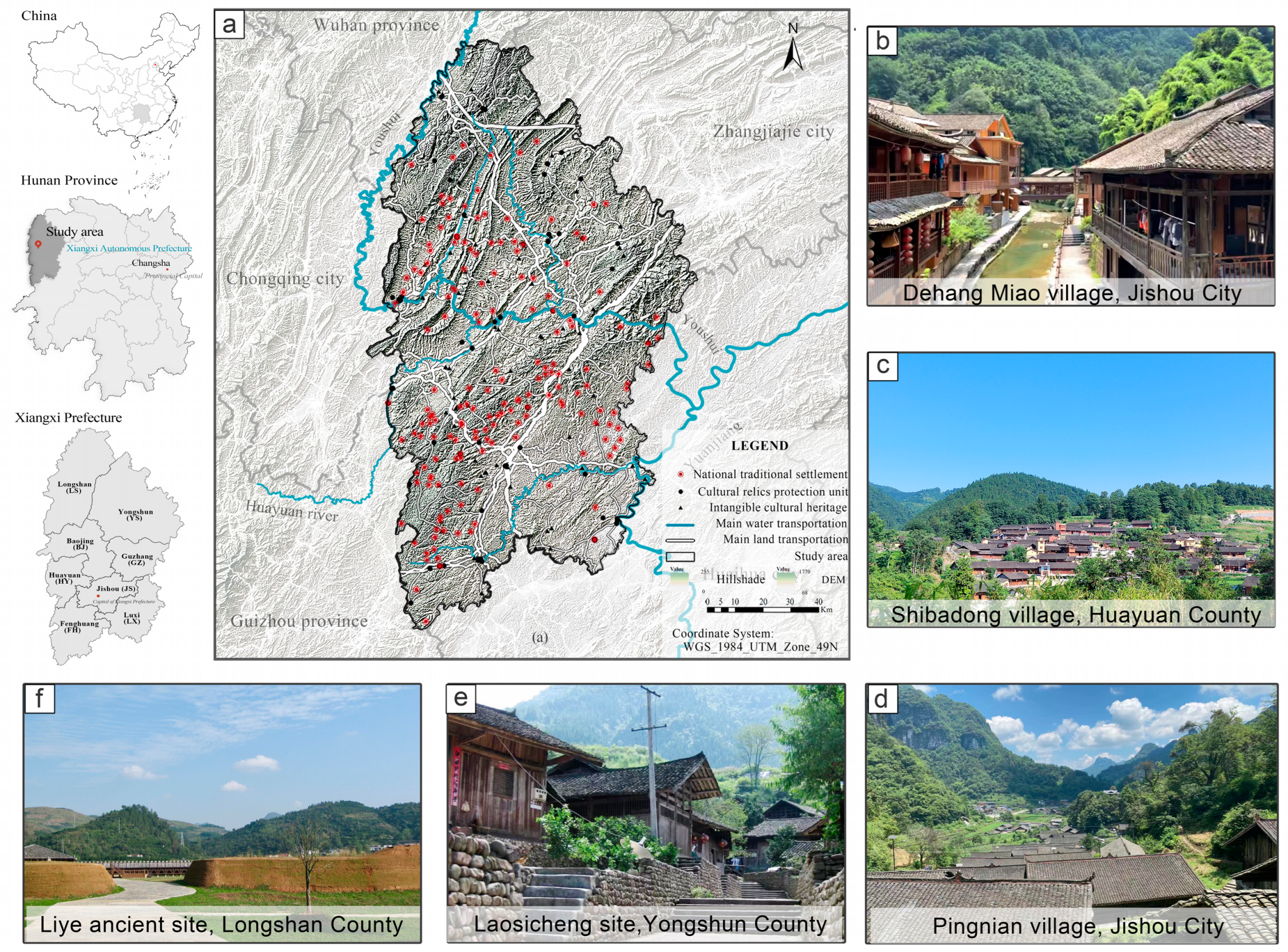
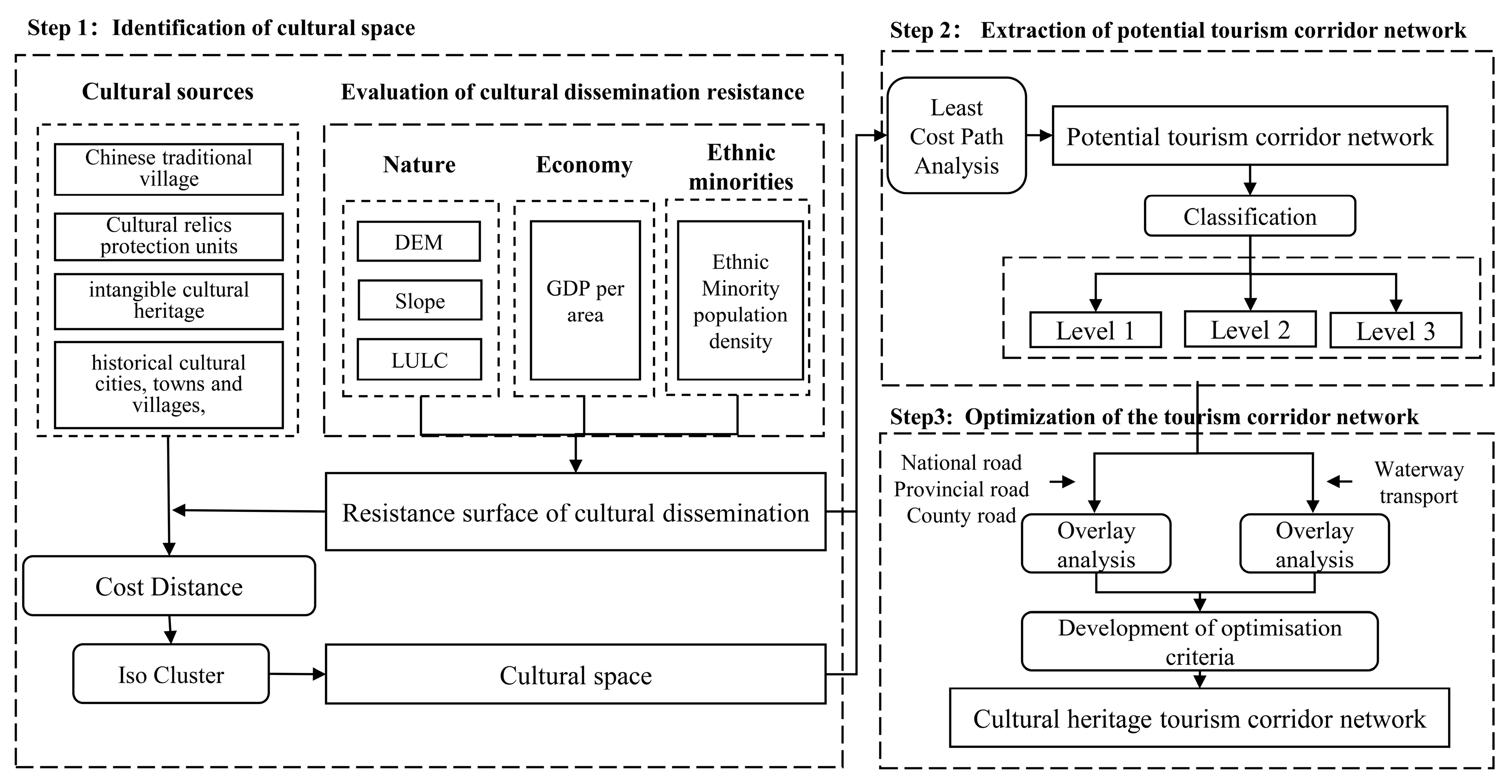
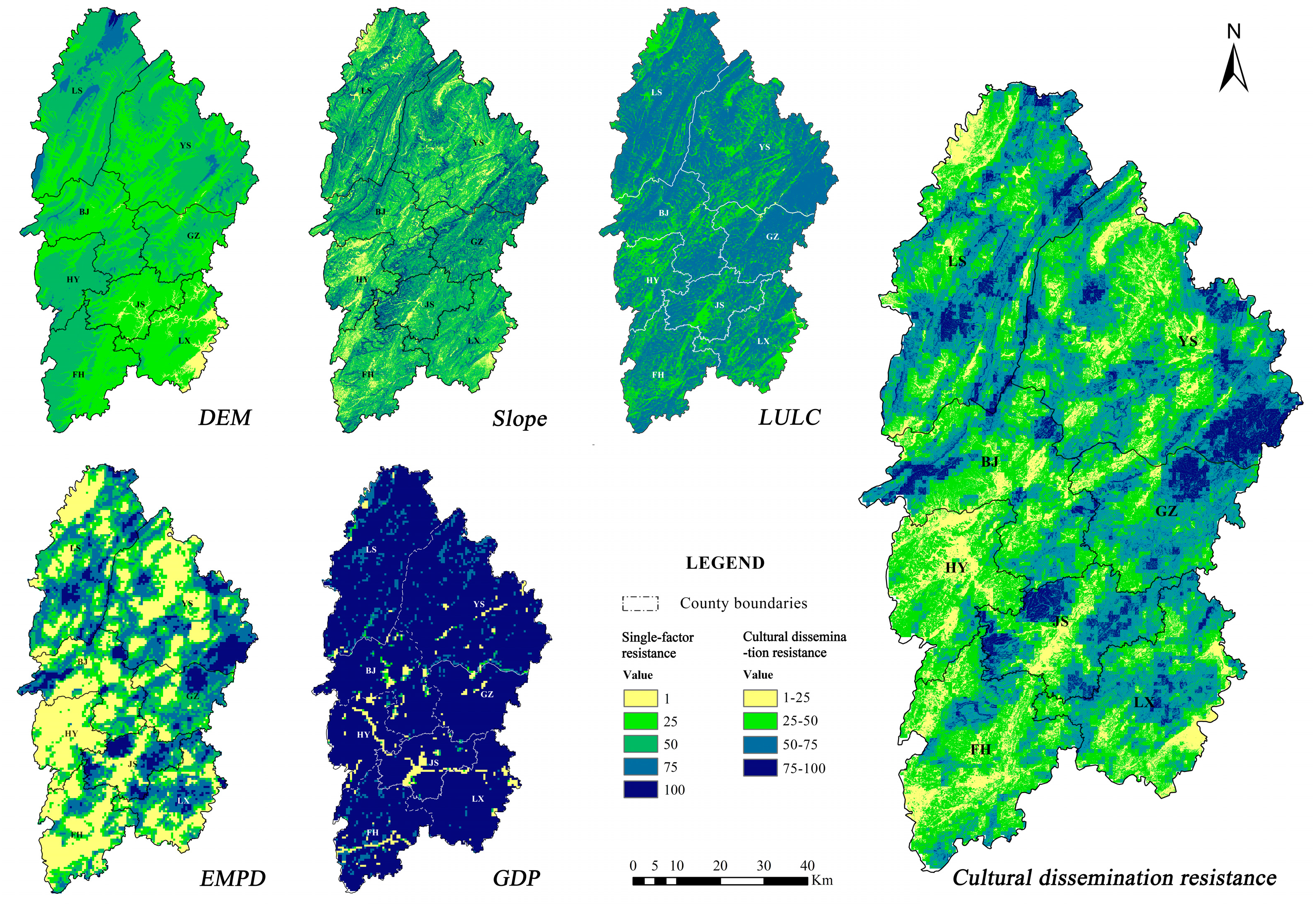
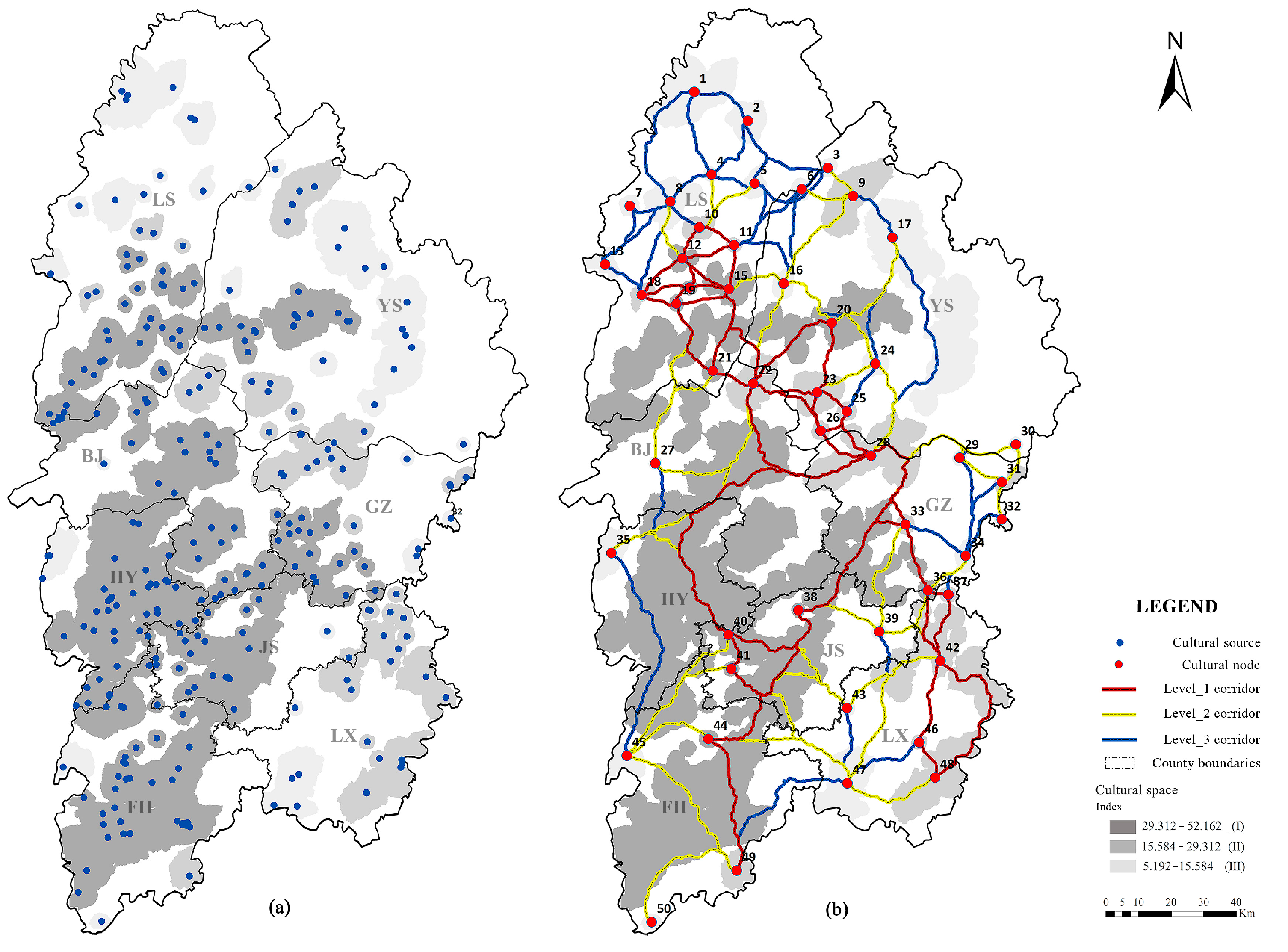
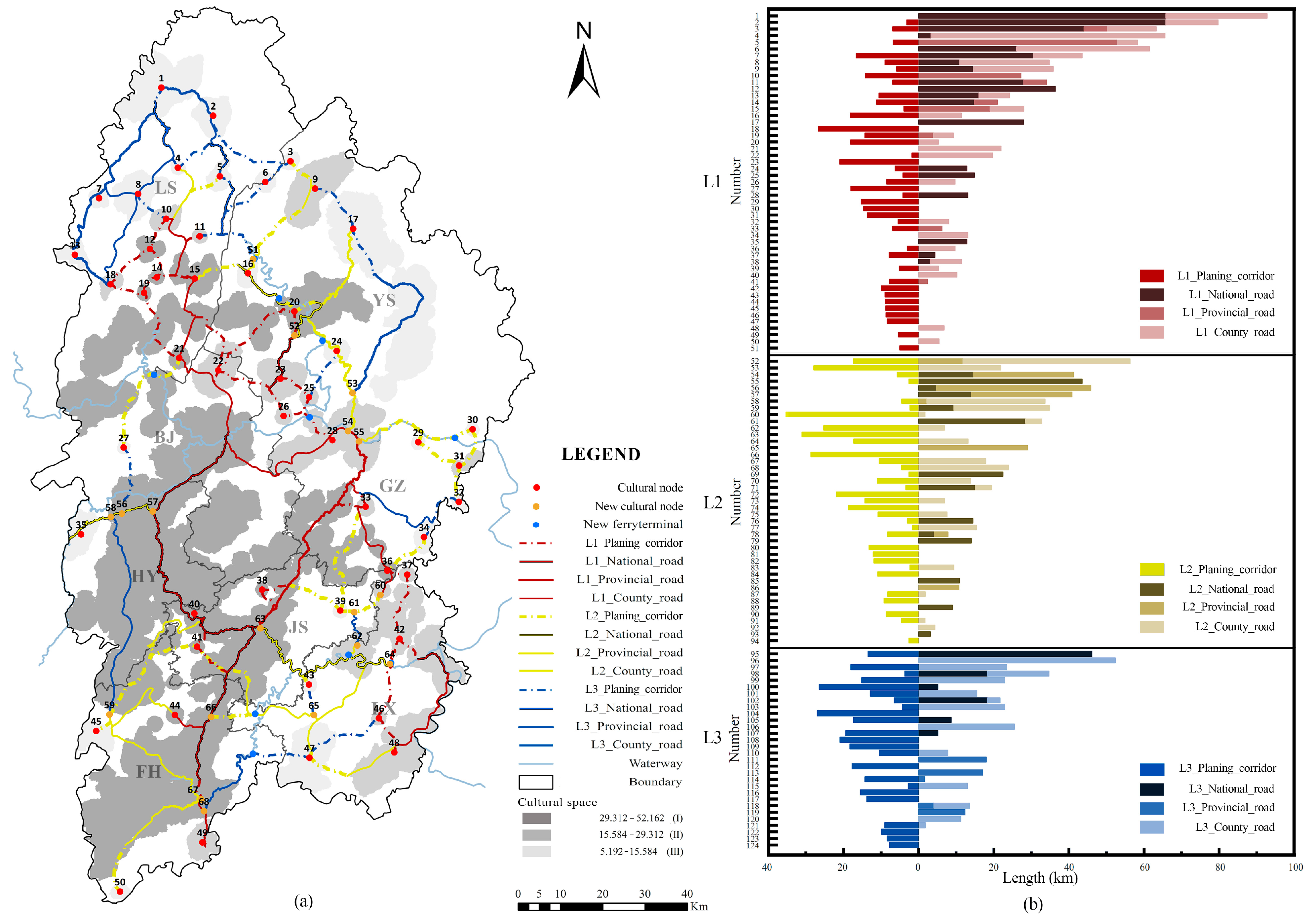
| Data (Product) | Type | Time | Source |
|---|---|---|---|
| DEM (m) | Raster (30 × 30 m) | 2020 | NASADEM Merged DEM Global 1 arc second, LP_DAAC Data Center, United States Geological Survey (USGS) (https://lpdaac.usgs.gov/proucts/nasadem_hgtv001/, accessed on 30 July 2021). |
| LULC | Raster (30 × 30 m) | 2020 | GLC_FCS30_2020, Aerospace Information Research Institute, Chinese Academy of Sciences (https://data.casearth.cn/sdo/detail/5fbc7904819aec1ea2dd7061, accessed on 1 September 2021) |
| Slope (°) | Raster (30 × 30 m) | 2020 | From the processing of DEM data. |
| Population density (People per km2) | Raster (1 × 1 km) | 2020 | The spatial distribution of population density in China, WorldPop and Center for International Earth Science Information Network (CIESIN) (https://www.worldpop.org/geodata/summary?id=39793, accessed on 18 February 2022) |
| Population in counties of Xiangxi Prefecture | Statistics | 2020 | The People’s Government of Xiangxi Tujia and Miao Autonomous Prefecture (http://www.xxz.gov.cn/zfsj/, accessed on 30 October 2021/). |
| EMPD (People per km2) | Raster (1 × 1 km) | 2020 | Raster calculation: Minority population proportion by county (minority population by county/total population by county) × the spatial distribution of population density in Xiangxi Prefecture |
| GDP (104 yuan per km2) | Raster (1 × 1 km) | 2015 | National Earth System Science Data Sharing Infrastructure, National Science and Technology Infrastructure of China (http://www.geodata.cn, accessed on 8 February 2022). |
| GDP per area (104 yuan per km2) | Raster (1 × 1 km) | 2020 | Raster calculation: GDP growth rate by county × the spatial distribution of GDP per area in Xiangxi Prefecture |
| Factor | Subfactor | Resistance Value Assignment | Basis of Classification | ||||
|---|---|---|---|---|---|---|---|
| 1 | 25 | 50 | 75 | 100 | |||
| Nature | DEM (m) | <200 | 200–500 | 500–1000 | 1000–1500 | ≥1500 | The average height of topographical features such as plains, plateaus, hills, and mountains were used to classify resistance levels. |
| Slope (°) | <5 | 5–15 | 15–25 | 25–35 | ≥35 | Refer to “General Rules for Integrated Soil and Water Conservation Planning GB/T15772-2008”. | |
| LULC | Water | Crop, Impervious surfaces | Open forest 1, Shrub, Grass | Closed Forest 1, Wetlands | Bare areas | 1: Water transport was the primary mode of conveyance for culture dissemination in past periods, and so water is most suitable for the dissemination and exchange of culture; 25: These are hubs of human activity that act as catalysts for cultural exchange; 50: These areas have ecological and aesthetic significance and can be developed and utilized for tourism activities in a suitable manner; 75: They are managed for ecological conservation, should be less disturbed by humans, and are not suited for development; 100: Poor environmental and scenic quality, making it unfit for tourists. | |
| Ethnic minorities | EMPD (people per km2) | ≥100 | 75–100 | 50–75 | 25–50 | <25 | Since 100 represents the threshold value for densely populated areas, classes are divided as follows: within the range of 0–100, classes are divided equally, and classes exceeding 100 are combined. |
| Economy | GDP (104 yuan per km2) | ≥1000 | 750–1000 | 500–750 | 250–500 | <250 | Since 1000 represents the threshold value for a developed economic level, classes in the range of 0–1000 are divided into equal groups, whereas classes above 1000 are combined into a single group. |
| Corridor Class | Connection of Cultural Spaces | Significance |
|---|---|---|
| Level 1 | I–I, I–II, II–II | High |
| Level 2 | I–III, II–III | Middle |
| Level 3 | III–III | low |
| No. | S | No. | S | No. | S | No. | S | No. | S |
|---|---|---|---|---|---|---|---|---|---|
| 1 | 21–40 | 26 | 11–14 | 51 | 36–37 | 76 | 16–20 | 101 | 5–11 |
| 2 | 22–40 | 27 | 37–42 | 52 | 45–50 | 77 | 4–10 | 102 | 1–4 |
| 3 | 38–49 | 28 | 40–41 | 53 | 40–45 | 78 | 15–16 | 103 | 33–34 |
| 4 | 21–28 | 29 | 64–46 | 54 | 17–20 | 79 | 56–35 | 104 | 2–3 |
| 5 | 28–38 | 30 | 25–28 | 55 | 64–43 | 80 | 34–36 | 105 | 5–6 |
| 6 | 57–28 | 31 | 12–18 | 56 | 17–24 | 81 | 60–39 | 106 | 8–18 |
| 7 | 41–49 | 32 | 10–11 | 57 | 17–52 | 82 | 29–31 | 107 | 6–11 |
| 8 | 42–48 | 33 | 38–63 | 58 | 45–67 | 83 | 65–47 | 108 | 46–47 |
| 9 | 44–49 | 34 | 67–49 | 59 | 64–47 | 84 | 30–31 | 109 | 27–56 |
| 10 | 33–38 | 35 | 52–23 | 60 | 41–45 | 85 | 35–58 | 110 | 2–4 |
| 11 | 38–40 | 36 | 11–15 | 61 | 62–64 | 86 | 53–54 | 111 | 1–2 |
| 12 | 57–40 | 37 | 23–26 | 62 | 55–30 | 87 | 3–9 | 112 | 11–51 |
| 13 | 41–44 | 38 | 66–44 | 63 | 21–27 | 88 | 31–32 | 113 | 7–13 |
| 14 | 38–41 | 39 | 42–64 | 64 | 9–16 | 89 | 56–57 | 114 | 9–17 |
| 15 | 28–33 | 40 | 68–49 | 65 | 24–54 | 90 | 60–61 | 115 | 4–8 |
| 16 | 15–22 | 41 | 14–15 | 66 | 33–39 | 91 | 59–45 | 116 | 32–34 |
| 17 | 40–63 | 42 | 46–48 | 67 | 65–66 | 92 | 51–16 | 117 | 24–25 |
| 18 | 20–22 | 43 | 18–19 | 68 | 44–45 | 93 | 56–58 | 118 | 7–8 |
| 19 | 28–55 | 44 | 23–25 | 69 | 63–43 | 94 | 39–61 | 119 | 13–18 |
| 20 | 42–46 | 45 | 25–26 | 70 | 47–48 | 95 | 17–53 | 120 | 61–62 |
| 21 | 15–21 | 46 | 10–12 | 71 | 62–43 | 96 | 58–59 | 121 | 4–5 |
| 22 | 33–36 | 47 | 12–14 | 72 | 38–39 | 97 | 47–68 | 122 | 8–10 |
| 23 | 19–21 | 48 | 36–60 | 73 | 55–29 | 98 | 1–8 | 123 | 3–6 |
| 24 | 20–23 | 49 | 14–19 | 74 | 29–30 | 99 | 32–33 | 124 | 43–65 |
| 25 | 41–63 | 50 | 54–28 | 75 | 5–10 | 100 | 6–51 |
Disclaimer/Publisher’s Note: The statements, opinions and data contained in all publications are solely those of the individual author(s) and contributor(s) and not of MDPI and/or the editor(s). MDPI and/or the editor(s) disclaim responsibility for any injury to people or property resulting from any ideas, methods, instructions or products referred to in the content. |
© 2022 by the authors. Licensee MDPI, Basel, Switzerland. This article is an open access article distributed under the terms and conditions of the Creative Commons Attribution (CC BY) license (https://creativecommons.org/licenses/by/4.0/).
Share and Cite
Huang, Y.; Shen, S.; Hu, W.; Li, Y.; Li, G. Construction of Cultural Heritage Tourism Corridor for the Dissemination of Historical Culture: A Case Study of Typical Mountainous Multi-Ethnic Area in China. Land 2023, 12, 138. https://doi.org/10.3390/land12010138
Huang Y, Shen S, Hu W, Li Y, Li G. Construction of Cultural Heritage Tourism Corridor for the Dissemination of Historical Culture: A Case Study of Typical Mountainous Multi-Ethnic Area in China. Land. 2023; 12(1):138. https://doi.org/10.3390/land12010138
Chicago/Turabian StyleHuang, Yihe, Shouyun Shen, Wenmin Hu, Yurou Li, and Guo Li. 2023. "Construction of Cultural Heritage Tourism Corridor for the Dissemination of Historical Culture: A Case Study of Typical Mountainous Multi-Ethnic Area in China" Land 12, no. 1: 138. https://doi.org/10.3390/land12010138
APA StyleHuang, Y., Shen, S., Hu, W., Li, Y., & Li, G. (2023). Construction of Cultural Heritage Tourism Corridor for the Dissemination of Historical Culture: A Case Study of Typical Mountainous Multi-Ethnic Area in China. Land, 12(1), 138. https://doi.org/10.3390/land12010138





